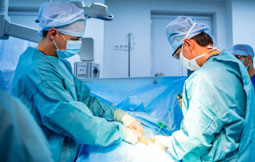
A stem cell transplant also referred to as bone marrow transplant, is a procedure that is performed for certain types of cancer or in the cases when the bone marrow stops working and can’t produce enough healthy cells.
A stem cell transplant also referred to as bone marrow transplant, is a procedure that is performed for certain types of cancer or in the cases when the bone marrow stops working and can’t produce enough healthy cells. The procedure involves replacing unhealthy blood-forming cells with healthy cells (called stem cells) in the body. Stem transplantation is of two types – one that involves using your own healthy cells (autologous transplant) and the other that involves using cells from a donor (allogeneic stem cell transplant). To eliminate blood cancer in the marrow and then restoring normal blood cell production doctors often use large doses of chemotherapy or radiation therapy.
A stem cell replacement helps to generate healthy cells (new stem cells) in the body that can help in destroying the cancer cells directly. Also, it provides you with the opportunity to safely opt for heavy chemo and radiation and thus, gives you a better chance of fighting cancer. The procedure also helps in treating cancerous and noncancerous diseases including:
Before you undergo stem cell transplantation your doctor will conduct a series of tests over a few days to check if you are physically fit for the cell transplantation or not. To infuse the transplanted stem cells and other blood products and medicines into your body your doctor will insert a long thin tube from your neck or chest into a large vein in the body. Once this pre-transplantation process and tests are done, the next step is the ‘conditioning regimen’ process in which you will undergo chemotherapy and radiation in order to:
You might feel following ill effects after the conditioning process:
The treatment is performed once the conditioning is finished. This treatment doesn’t require anesthesia and the patient is kept awake. The procedure is carried out when the Donor’s stem cells are transferred to the patient’s body by infusion using the thin tube inserted before. Once the cells are transplanted into the body, they start producing new blood cells in a process called engraftment. This helps in recovering the blood count of the body. The blood cells contain a preservative called dimethyl sulfoxide which helps in guarding the cells. You might also be given some medications in order to reduce the adverse effects of this preservative. Some of the common symptoms you may feel include fever and chills, nausea, hives, diarrhea, and red urine.
Post-treatment you will be kept under observation and your doctor will continuously monitor your health. You might also have to stay longer in the hospital if there is any complication or infection. Before you leave the hospital, your doctor will make sure that you are able to eat food and drinks on your own without any difficulty, and there are no ill effects like fever, vomiting, or diarrhea and your body have safe levels of blood counts. You may recover anywhere between 30 to 100 days after the transplant, depending on your prevalent condition and overall health.
There might be a certain set of risks and complications that you will be already explained before beginning the procedure by your doctor. Some of the very common risks include:
Copyright © 2025 IMA | All Rights Reserved.